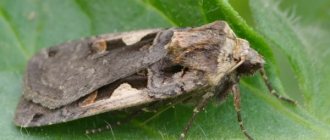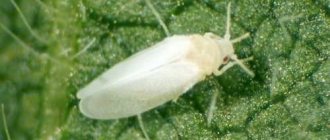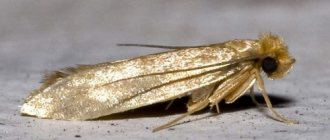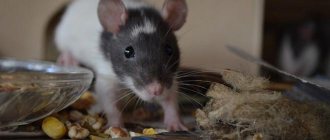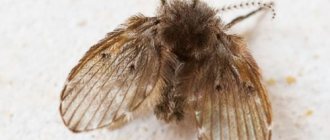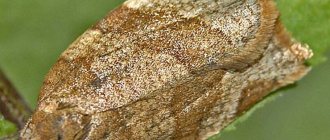Types of cutworms dangerous for tomatoes
Cutworms (Noctuidae) or noctules are one of the largest families of lepidopteran insects. According to the latest data, it includes more than 1,000 genera and about 12,000 species. Information that the family contains 36,000 species is outdated. Noctuid moths are excluded. There are 24,000 species in a separate family, Erebidae.
Noctuids are distributed throughout the globe - from the Arctic to Africa. More than 1,500 species can be found in Russia.
Cutworms are medium-sized butterflies with a round head and two pairs of wings. They fold along the body in a horizontal plane, are distinguished by their triangular shape and faded colors.
The front wings are decorated with a characteristic cutworm pattern consisting of three fields called bands. The spots are not randomly located, but form a system; three of them are usually called the main ones and are described when defining the taxon: round, wedge-shaped and kidney-shaped. The pattern is clearly visible in the photo. In different scoops, it allows for deviations and variations that do not fit into the general scheme.
The pest's lifestyle is predominantly evening and nocturnal. For plants, including tomatoes, it is not butterflies that pose a danger, but caterpillars. They go through several molts and have 5-6 instars.
When they are at different stages of development, the harmfulness of the caterpillars changes. Pupation occurs in the ground, at a depth of 5-7 cm, in some species in spring and summer - on leaves and stems.
Most cutworms are polyphagous, meaning they can feed on different crops. Some species are recognized as dangerous quarantine pests. It is with them that gardeners are forced to fight for the harvest. The only good thing is that the measures to combat the fall armyworm on tomatoes are the same, regardless of the type.
Cotton bollworm
Helicoverpa armigera is a polyphagous pest. It is an inconspicuous butterfly with a wingspan of 3-4 cm in the front wings, bordered by a brown stripe. Their main color is gray-yellow, with reddish, green and pinkish impurities. In the center is a dark mark that looks like a sickle. Round and kidney-shaped spots are gray, decorated with fuzzy transverse lines.
Caterpillars 3.5-4 cm long are covered with small growths, called spines in biology, and are distinguished by three dark longitudinal stripes on top and one yellow stripe on the bottom. The color of the body is variable, it can be:
- white;
- yellow;
- brown;
- green;
- black.
In Russia, the bollworm feeds on tomatoes and 120 other plant species. In the first period, the caterpillar gnaws on leaves, then moves into the stems and eats tomatoes.
The temperature favorable for the development of the pest is from 22 to 28° C, the minimum is 18° C. Fertility is 300-2700 eggs. In the middle zone, 1 generation manages to appear, in the south - 2-3. The complete development cycle from egg to mature butterfly depends on temperature and usually lasts 30-35 days. Of these, 13-22 are larvae (caterpillars).
It is believed that cutworms on tomatoes begin to pose a problem if their number exceeds 10-12 larvae or 20 eggs per 100 bushes. This indicator is usually called the threshold of harmfulness. The pupae overwinter.
Scoop Gamma
Phytometra gumma is distributed throughout the European part of Russia: in the Caucasus, Far East, Central Asia and Western Siberia. It affects 100 species of cultivated plants, including tomatoes.
Wingspan – 4-4.8 cm. Color – from gray to brown, with a purple tint. The name is derived from the marking, shaped like the Greek letter γ (gamma), silvery in color, located on the front pair of wings. The kidney-shaped and round spots are bordered.
Caterpillars that parasitize tomatoes are green, with two fuzzy, sinuous white stripes on their backs. Spiracles are yellow. Length 2.4-4 cm.
The gamma cutworm differs from other species by black spots on the sides of its head.
The larva goes through 5 instars. At the initial stages it requires high humidity (90-100%). It belongs to the leaf-eating type - it eats the plates of tomatoes and other crops, leaving only large veins. Then it becomes able to gnaw through the flowers and fruits of tomatoes.
The optimal temperature for life is 20-25° C, the minimum is 17° C. The full development cycle is 25-45 days, of which 16-25 are at the larval stage, when the caterpillars actively eat tomatoes. In the north it gives 1 generation, in the southern regions - 3, sometimes 4.
In summer it pupates on the tops or under the leaves of plants. With the onset of cold weather - in the ground. Not only pupae, which can withstand temperatures down to -18° C, overwinter, but also butterflies and caterpillars.
exclamation scoop
Agrotis exclamationis is a gnawing cutworm, a broad polyphagous species. It lives throughout the European part up to the Arctic Circle. Found in the Far East, the Caucasus, Kamchatka, and Siberia. It affects 75 plant species, including tomatoes. In the North it produces 1 generation, in the southern regions - 2.
A butterfly with a wingspan of 3.2-4.5 mm. Color ranges from gray with a yellow tint to brown. Spots:
- kidney-shaped – black-brown;
- round – a little lighter;
- wedge-shaped is a narrow black stripe.
The caterpillars are grayish-brown or faded yellow, 3.3-5 cm long, covered with pimples. The head is red. Damages tomato stems at ground level. Adult caterpillars overwinter and can withstand low temperatures well even in the North. In the spring they eat off and only then pupate.
Fall armyworm
Agrotis segetum is a cutting armyworm, a polyphagous pest of tomatoes and 150 other crops. The range in Russia covers the entire European part, Southern Siberia, Transcaucasia, and the Far East. In the North, only 1 generation develops, as you move south - up to 4. Favorable temperature - from 16 to 30 ° C, minimum - 10 ° C.
The wingspan is 3-4.6 cm. The color of the front wings is rarely purely gray, usually with an admixture of brown. The transverse stripes are clear. Spots:
- wedge-shaped - small, gray, with a black outline;
- round - in the shape of a disk or oval, light, with a thin charcoal border;
- kidney-shaped with regular outlines, large, dark gray in the middle, much lighter on the periphery, with black edging.
Caterpillars are 4-5 cm long, brown-gray, glossy. The head is red, there are small pimples and dark longitudinal stripes on the body.
At the 1st-2nd stage of development, the larvae of the winter cutworm usually feed on weeds, since they are characterized by an early appearance - the cultivated plants have not yet been planted. They can damage seeds and eat up seedlings of early varieties of tomatoes, other vegetables and herbs.
Caterpillars, starting from the third instar, rise higher and gnaw leaves, leaving only large veins. The fruits, including tomatoes, are not touched. The caterpillars feed on leaves until October, then burrow into the ground to a depth of 10 to 25 cm.
The full development cycle is usually 50-70 days. The duration of the larval (caterpillar) stage depends on temperature and region, lasting from 24 to 36 days. In the North, winter cutworms travel from the ovipositor to the adult individual over a much longer period of time. Sometimes the caterpillar stage there lasts up to 100 days.
Adult larvae overwinter and can withstand -11, and at low humidity -18° C. Young caterpillars in the south survive at -5° C.
Cutworm
Lacanobia oleracea, synonym – Lettuce armyworm, is a polyphagous pest of agricultural crops that also affects tomatoes. Distribution in Russia - the entire European part, the Caucasus, Transcaucasia, Siberia, the Urals, the Far East.
The wingspan is 3.3-4.2 cm, the color is brown with a reddish tint. Spots: kidney-shaped - orange or yellow, round - dark, both surrounded by a white rim. Fertility – 400-1500 eggs.
The caterpillars are covered with spots: small light and large black, bristly. Body color can be green, brown with a yellow or red tint. The head and spiracles are yellow.
They damage the leaves of ornamental and agricultural plants, including tomatoes.
If representatives of the Chenopodiaceae or Asteraceae families grow near the beds or greenhouses, the garden cutworm will pay attention primarily to them. And then he will move to the garden.
The pest lives in the larval stage for 30-40 days. The pupae overwinter in the ground. In the North, 1 generation develops, in warm climates - 2.
Scoop Karadrina
Spodoptera exigua has a second name - tomato cutworm. A polyphagous pest, its food list includes 185 crops, including tomatoes. In Russia, the species' range extends across southern Siberia and Europe. The pest is found in the Trans-Urals, Transcaucasia, and the Far East.
Butterflies are brown-gray in color, with a wingspan of 2.3-2.4 cm. The round spot seems to be covered with fresh rust, the kidney-shaped spot is dull brown. Lays eggs in groups of 300 or more. Gives up to 3 generations. Summer – from May to October.
The caterpillars are green to brown, 2.5-3 cm long. On the back there are several thin lines covered with hairs, on the sides there are wide dark stripes on top, yellow underneath. There are white spots near the spiracles. It lives 14-25 days before turning into a pupa.
The Karadrina armyworm loves tomatoes and other nightshade crops. At the initial stages of development, the caterpillars bore holes and skeletonize the leaves. Tomato fruits and flowers are affected by adult larvae when they spread strongly. The pupae overwinter.
In addition to the listed species, cabbage and clover armyworms can parasitize tomatoes. But if there is another food supply, they prefer more familiar crops. On tomatoes they are destroyed in the same way as other species.
Where does the cutworm come from on tomatoes?
In greenhouses, greenhouses and vegetable gardens, cutworm pupae and caterpillars overwinter in the ground. Suitable conditions in cold climates are created by plant residues that have not been harvested since autumn, warming the soil. Sometimes the armyworm enters the site along with purchased soil, “enriched” with the pest overwintering there.
Coming to the surface, the pest begins to feed on weeds. By the time crops are sown or planted, the cutworm is usually ready to lay eggs.
It is impossible to completely prevent its occurrence even by annual deep digging and disinfection of the soil in the fall. The armyworm flies well and can move from a neighboring area or migrate from afar.
Some species are capable of covering vast distances with air currents. In the Far East you can sometimes even find tropical cutworms. But they do not overwinter there and die at the end of the season.
Harm of cutworms
The potential fertility of the cutworm is 2 thousand eggs. It is especially unpleasant that some species lay one butterfly per leaf, and one butterfly can infect a huge area. Other cutworms can leave 300 or more eggs on the underside of a tomato leaf blade.
Butterflies do not pose a danger to tomatoes, and even bring some benefit by participating in pollination. The pests are larvae that live quite a long time.
If in the south their development can last 2 weeks, then in the northern regions the caterpillars of the Winter Armyworm sometimes feed for up to 100 days until they pupate.
During the day, the larvae hide under leaves or plant litter, and feed in the evening and at night. Cutworm - crop pests are conventionally divided into three groups:
- leaf-eaters, whose food base is tomato leaves;
- gnawing cutworms damage the roots and lower part of tomato shoots, most belong to the Agrotis subfamily;
- intrastem ones gnaw into soft tissue, live and feed inside the plant until the time comes to pupate.
But it’s not for nothing that moths are called omnivores. Caterpillars in the early stages of development usually skeletonize and gnaw tomato leaves. Then they may well move onto tomato fruits, damaging them in the area of the stalk.
Gnawing cutworms prefer not to rise high; they feed on flowers and tomatoes if they lie on the ground.
Caterpillars of the first and second groups damage tomato fruits only when they spread strongly. If the beds and greenhouses are treated, their “activity” will, although it will affect fruiting due to inhibition of bush growth, but only a few ovaries will be eaten away.
Who is the exclamation owl and how to deal with it?
Another subspecies of pest for garden and grain crops is the moth, which multiplies rapidly and is quite common. The insect received its unusual name because of the same unusual color of its wings - with an image resembling an exclamation mark.
The caterpillar of this pest is gray-brown with a hint of yellow and is about 5 mm in length. In adulthood, they move underground during the cold season. The depth of the caterpillars' habitat sometimes reaches 30 cm. It is underground that insects wait in complete safety for spring to pupate.
exclamation scoop
The pest lays cutworm eggs on the leaves of weeds and even on the soil, several dozen at a time. The caterpillars become viable within a week. The first days they are especially careful, but as soon as night falls, they go in search of food, gnawing leaves of crops down to the veins, eating roots, fruits, and seed embryos. During the summer, only one generation of the insect has time to mature.
How to detect a pest on tomatoes
Most cutworms begin feeding not at night, but during dusk. The caterpillars are not that small; in the evening they are easily detected by people with good eyesight.
But you can see them on the underside of tomato leaves in the middle of the day. If the bed or tomatoes in the greenhouse are mulched with grass or other plant debris, you need to rake the litter. It is likely that the larvae wait out the daylight hours there.
There should be no talk of weeds. If you do not get rid of them, protecting tomatoes by spraying and other methods will become ineffective.
Butterflies also appear in the evening. If you go out into the garden or visit a greenhouse at dusk, you can see flying pests - their wingspan is quite large.
Scoop eggs are white, yellow, and light green in color. They are clearly visible on leaves, weeds and plant debris, even if deposited one at a time.
It is much worse when it is not the pest that is found, but signs of its activity - gnawed and skeletonized leaves, which only have large veins left, a damaged stem or caterpillars inside the tomatoes.
How to treat tomatoes against cutworms
What to do if cutworm appears on tomatoes? This pest is well-known; it can be destroyed using traditional methods or chemicals. Another thing is how to deal with caterpillars. Whether to immediately spray tomatoes with strong preparations, set traps, or save the crop in another way depends on the stage of infection of the crop.
Drugs
The earlier the cutworm is detected on tomatoes, the more gentle control methods can be chosen. Ideally, prevent butterflies from laying eggs. Then you can avoid using chemicals and make do with biological products.
Chemical
To protect tomatoes severely affected by cutworms in greenhouses and open ground, enteric and contact chemicals are used for treatment:
- peritroids;
- organophosphorus compounds;
- quinine synthesis inhibitors;
- neonicotinoids.
For private farms, the following preparations for the fall armyworm on tomatoes are recommended:
- Alatar;
- Decis Profi;
- Herald.
On farms and agricultural enterprises, you can use stronger insecticides against cutworms on tomatoes:
- Samurai Super;
- Decis Profi;
- Cyperus;
- Kinfos;
- Fascord;
- Europir;
- Imidor;
- Tibor;
- Clonrin.
Preparations for the fall armyworm on tomatoes are not limited to this list; new, safer ones appear every year. For example, Initiator 200 from Bayer. Available in tablets, it is both a systemic insecticide and a long-acting fertilizer for tomatoes. It is expensive, but it works for 1-2 years. With its help, it makes sense to fight the greenhouse cutworm on tomatoes. There, Initiator 200 is less washed out by rain.
Biological
In order not to spray tomato plantings with poison, if the cutworm is detected early, or its moderate spread, you can use preparations of biological origin:
- Bitoxibacillin. It is a bacterial insecticide and a biological intestinal pesticide. It does not accumulate in tomatoes and is non-phytotoxic. The waiting period is 5 days. Hazard class – 3. Compatible with most chemical pesticides and other biological preparations.
- Lepidocide against the cutworm helps well, has a hazard class of 4. Has the same properties as Bitoxibacillin.
- Agravertine is a natural neurotoxin. It lasts 2-3 weeks on the surface of tomatoes. Decomposes in soil within 2 days. The armyworm stops feeding after a maximum of 10 hours and dies within 2-3 days.
- Actofit is an intestinal bioinsecticide. Not addictive.
- Fitoverm is a biological preparation. It is a contact-intestinal pesticide and avermectin. Today it is one of the most powerful biological insecticides.
Contrary to erroneous belief, Fitoverm is not a bacterial preparation. It is created on the basis of waste products of the fungi Streptomyces avermitilis.
Folk remedies
You can protect tomatoes from cutworms using folk remedies at an early stage of detection. According to reviews, infusions of the following herbs have a good effect on pests:
- chamomile;
- burdock;
- dope;
- spurge;
- yarrow.
Half a bucket of green mass is topped up with water. They insist for 3 days. Before use, strain, add any adhesive or solution of laundry soap.
Infusions of garlic, onions, wormwood and other plants with strong odors are more effective at removing butterflies from tomatoes. Here you don’t need so much crushed raw material. You can pour it in the evening, and spray the tomatoes in the morning. Or vice versa. Otherwise, the smell of the infusion will fade and the effectiveness will decrease.
Ammonia has the most “killer” aroma. For 10 liters of water, 50 ml of the drug is enough. The owls do not like him and fly away to another area. But ammonia is also a nitrogen fertilizer for tomatoes. You can protect tomatoes from cutworms, but overfeed them with nitrates, which will reduce the yield.
In addition, the substance has a pungent odor and can pose a danger to humans. You need to work in a respirator, rubber gloves and safety glasses.
Options for getting rid of the pest
When dealing with the question of how to get rid of caterpillars on tomatoes, gardeners try all sorts of tricks - advice from neighbors, buying special insecticides, planting plants that repel the pest and other effective methods.
Among the means available to summer residents, the following methods are used:
- Chemical treatment. In this case, you cannot do without purchasing pesticides to poison insects.
- Biological poisoning. Here, “gentle” agents are used to treat developing plants.
- Folk remedies. This option involves destroying caterpillars using time-tested methods.
The choice of a specific approach is determined by personal experience and the current situation. Let’s find out in more detail how effective the listed points are, and how to save the plantings with minimal damage.
Chemical attack
Let's start with an effective, but not the safest way - treating the garden with pesticides of hazard classes 1–3. Such actions guarantee the death of the insect population. However, it is recommended to treat plants with “heavy” chemicals at the flowering stage. This point is explained by the time frame for removing harmful substances from the soil and bush, which is up to 20–30 days.
The list of similar “working” drugs that have received favorable reviews includes “Inta-Vir” and “Avant”. Both products destroy pests at any stage of development. To poison insects, you need to initially spray the seedlings, and then repeat the procedure after 2 weeks. “Tsitkor”, “Decis”, “Arrivo” and “Zeta” act in a similar way.
Advice . The use of such “heavy weapons” becomes advisable in case of serious invasions of illegal tomato lovers and only at the initial stage of bush development.
Organic products
Now let's move on to studying the second method of action in a situation where caterpillars have attacked tomatoes. What to do if the enemy is detected already at the stage of ovary formation? In such situations, experienced gardeners recommend biological insecticides.
Such substances are marked with the fourth hazard class and give a chance to spray bushes with already ripening fruits without consequences. “Fitoverm” and “Lepidotsid”, “Aktofit” and “Agrovertin”, “Admiral” and “Aktara” are removed from plants in a maximum of 15 days. The disadvantage of using this method is that the caterpillars get used to the action of the pesticide.
Good to know . Periodically changing the brand of the selected protective equipment increases the efficiency of the work performed.
People's experience
Let’s move on to methods that have been proven over dozens of generations and are “harmless” to the health of plants and people. Treating tomatoes against caterpillars with folk remedies is accessible and inexpensive, and most importantly, it is no less effective than, for example, using chemicals. However, we note that this method will be effective only if small insect colonies are detected.
Regular laundry soap comes to the rescue. A strong solution with water in the proportion of a third of a bar per bucket of liquid and regular watering increase the chances of protecting the plants.
The following components will help enhance the effect:
- Tobacco . To create a decoction, take 300 g of shag and dilute it in a bucket of boiling water. Then let the mixture sit for a day and add a glass each to the prepared soap solution.
- Potato tops . The crushed leaves are steamed in a ratio of 1:10, left for up to 2 days, and a quarter of a bar of soap is rubbed into the mixture. The crops should be sprayed with this solution twice a day during morning and evening watering.
- Garlic . One head of the plant is crushed and poured with a liter of boiling water. Let the resulting solution stand for three days and add half a glass to the soap suspension. Making such a product is not difficult, and the result will pleasantly surprise you.
- Wormwood . The grass is finely torn, the bucket is filled to a third and filled with cold water. Then the mixture is boiled for 30 minutes and left for 2 days. The effectiveness of the effect on those who like to eat other people's tomatoes is achieved by adding the infusion to the soap mixture in a ratio of 1:10.
In addition to the options listed, you can spray damaged bushes with a strong saline solution. For three liters of liquid, use a pack of table salt and treat the beds.
Natural enemies of the cutworm
Birds peck the scoop from tomatoes, so in winter the birds need to be fed, and in summer they need to be attracted to the site in every possible way.
Butterflies have their own parasites:
- bracon;
- black banhus;
- tachina fly.
There are Trichogramma on sale - egg-eating insects that parasitize the cutworm. Their use is especially effective on tomatoes in greenhouses. They find a clutch of armyworms and release their own eggs inside. Trichogramma are less prolific than the pest. But they give 2-3 generations per 1 generation of armyworm.
Preventive actions
A common form of infection of tomatoes in a greenhouse is the entry of a butterfly through an open window. On the one hand, regular ventilation ensures the full development of the tomato, but on the other hand, you need to constantly ensure that pests do not enter the room. A mesh with small cells will help reduce the likelihood of such a development of events, through which pests will not penetrate inside. The list of preventive measures will continue with the tips listed below:
- constantly remove weeds;
- prevent the accumulation of rotten fruits and fallen leaves in the beds;
- before planting, the soil is treated using a solution of potassium permanganate (concentration 2:1), which destroys even those pests that survived the cold;
- Spray the seedlings with Citcor or Decis at least once every 3 weeks to increase immunity;
- do not use chemicals after fruit set;
- It is easier to destroy young animals than adults;
- After harvesting, all plant residues are collected and burned, otherwise the reappearance of the pest will not be long in coming.
In the summer, the beds are regularly loosened, due to which the masonry is destroyed. For preventive purposes, twigs should be placed at 5-7 points inside the greenhouse. Pieces of yellow paper soaked in honey or Vaseline are attached to them. Scientists have proven that the pest actively strives for such a trap. It must be updated every 6 days. The list of useful preventative tips continues with the recommendations below:
| Plant | Nature of impact |
| Celery or coriander | Planted between rows of tomatoes. The smell of the crop is so unpleasant to butterflies and caterpillars that they physically cannot get close to the seedlings. |
| Celandine | It is mixed with 100 g of wormwood, 500 g of tobacco, 50 g of shag and 250 g of garlic feathers. Everyone pour 11 liters of boiling water and leave for 30 hours. The finished mixture is filtered and ½ bar of laundry soap is added. The resulting solution is used to spray seedlings at least once every 6 weeks. |
| White mustard | It is planted in early spring, after it has sprouted a little. The closer it is to the tomatoes, the less chance the caterpillars have. Another option for using it is creating a solution. For every 1 liter of water take 100 g of dry matter. The resulting solution is sprayed onto the plants once every 5 weeks. |
The listed recommendations are effective only if they are used together with traditional preventive measures.
It is easier to prevent a problem than to try to eliminate its consequences. Before planting tomatoes in prepared holes, they are pre-treated with the drug “Prestige”. You can purchase it in a dispenser syringe.
For every 100 ml of the drug, take 50 ml of water. The seed is placed in the resulting solution for 25-30 minutes. As soon as the specified time period is over, future tomatoes are sent to the prepared holes. In most cases, a single application is sufficient to reduce the likelihood of fall armyworms and Colorado potato beetles throughout the season.
Caterpillar activity is observed with the onset of consistently hot and dry weather. Pests are leaving the dungeons where they spent the winter. Within a few days, they form pupae on the inside of the leaf, from which butterflies emerge. The latter lay several hundred eggs per season, after which they die. A gardener who regularly inspects his crops will immediately notice something is wrong. At the initial stage, traditional methods and biologically active substances are effective. As soon as the problem has become acute - butterflies have appeared, dosed use of insecticides is required.
Pests can destroy the entire tomato crop. The most effective fight against them will be if you start it at the first signs of plant infection. However, it is not always possible to detect a pest attack at the very initial stage. For example, the presence of a moth is difficult to immediately notice, and this can lead to significant damage in the future.
To prevent the loss of the entire harvest, take preventive measures in advance, as well as treat your beds with folk remedies that are completely safe for both vegetables and humans.
Why does someone eat tomatoes in a greenhouse: what kind of insect has appeared and the reasons for its appearance
It destroys not only tomatoes and can ruin the harvest of beans, eggplants, bell peppers, corn and other garden crops. However, she still gives the greatest “preference” to tomatoes.
In order not to lose the entire harvest, you need to begin destroying the pest as soon as its appearance in the greenhouse is established.
Signs of a cutworm
Some gardeners see with tears in their eyes how the still green tomatoes grown with such difficulty are covered with holes of various sizes.
Sometimes you can see a green caterpillar crawling out of the made windows and passages. Damaged fruits can no longer survive on the bush until harvest.
They first turn brown and then fall off. Is it possible to prevent the appearance of a dangerous pest? How to deal with it?
Gray, black or brown butterflies appear in the dark.
There are many varieties of cutworms.
Experienced gardeners have learned to check whether the armyworm has settled in the greenhouse. To do this, you will need a special trap, which is easy to make with your own hands.
Mechanical methods of control
Some gardeners collect cutworm larvae and large ovipositors on tomatoes by hand. But this can be done if the bed is small, but on a farmer’s field it is very problematic.
It is much easier to set up traps for cutworm butterflies in beds with tomatoes, both in a greenhouse and in open ground:
- place containers filled with beer, fermented jam or molasses diluted 3 times with water;
- Like all nocturnal moths, cutworms willingly fly into the light; they can easily be sprayed with insect repellent from a spray can or, if desired, killed by hand.
Fighting caterpillars: general rules
Caterpillars on tomatoes in a greenhouse: how to deal with them? To combat it, it is necessary to apply an integrated approach, which contains the following measures:
- In the spring, constantly destroy weeds. This will help reduce the number of larvae and butterflies.
- Inspect greenhouses regularly, especially during the flowering period.
- Spray with chemicals “Iskra” and “Leptotsid”. Repeat spraying after a week, since the caterpillars do not all appear at once. Then only biological substances can be used, because the period of ripening and harvesting does not tolerate chemicals. Repeat treatment 2-3 times.
- Do not allow the caterpillar to form to large sizes.
- In the autumn, it is necessary to destroy all remnants of plants that have been damaged by the caterpillar and dig up the bed.
- During the summer season, it is recommended to loosen the soil from time to time.
Prevention
Of course, cutworms can appear on tomatoes by flying from a neighboring area. But then it is much easier to deal with them than if you “breed” pests on plant debris or in the soil.
Preventive actions:
- Before the onset of frost, dig up or plow the soil to a depth of at least 10 cm;
- always remove plant debris from the site in the fall;
- in the spring, weed out weeds from the moment they appear, and not before planting tomatoes;
- during the summer of butterflies, spray tomatoes with infusions of garlic, wormwood or other herbs with a strong pungent odor;
- carry out preventive treatment of tomatoes with drugs that also act on the cutworm;
- alternate crops in garden plots;
- plant tagetis between the rows, pick flowers or leaves from time to time, knead them and throw them on the beds with tomatoes.
